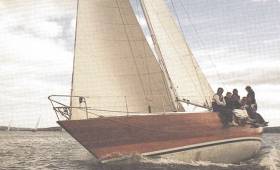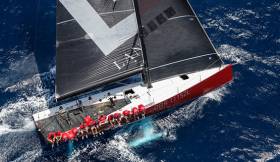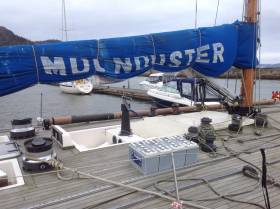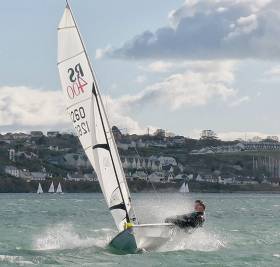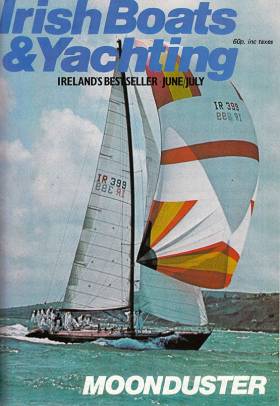Displaying items by tag: Royal Cork Yacht Club
Royal Cork Yacht Club Second in 2K Team Racing Anzio
Over 3 days and no less than 42 races it was all down to the last match between the Dutch and their great rivals from Royal Cork. It was one of those starts that one wants to forget, but the Dutch clearly down, gambled on banging the corners to great effect. Back in the action at the windward mark the four boats were all within a boat length then it all started to unravel for Cork.
2K Team Racing is two on two team racing, in keelboats, without spinnakers.
Twin penalties for Smit (NED) and Kingston(IRL) saw the game balanced. then Cudmore(IRL) collected a penalty for tacking too close... the Dutch are in the lead... a final Irish penalty and it is all over...as the Dutch move into their tried and tested tight defence mode for the final run to the finish.
Host team Rome had had a hard regatta, losing to a rookie British team from the Royal Thames and to the young Italians from 3CV sailing as Banana 2....but the final honours were to go to them as then outplayed the Dutch to the closest of finishes in the final match....but all too late for the podium.
1st Dutch Match and Team Race Association (NED)
2nd Royal Cork Yacht Club (IRL)
3rd Royal Thames Yacht Club (GBR)
The 2K Tour now moves to another Italian Yachting paradise in Gaeta.
The Rome 2K was hosted by the Platu 25 Class and the Reale Circolo Canottiere Tevere Remo at the club's Anzio base.
Archie O'Leary 1929–2016
In a well-lived life in Cork in which he was exuberantly involved in several sports and long active in a pioneering role in business, he was known to everyone as Archie O’Leary. Yet properly speaking he was Arthur O’Leary, sharing his name with the historic and heroic figure of Art O’Leary (1746-1773). But this modern Arthur O’Leary, who has now gone from among us at the age of 86, was of more than enough significance to merit his own distinctive name.
It was as Archie O’Leary that he played rugby for Ireland, rising through the ranks of Cork Con (where he was Captain) and Munster, to win three caps in the national side in 1952. It was Mr & Mrs Archie O’Leary who became well known in racing circles, their most famous and successful horse being Florida Pearl. And it was as Archie O’Leary that he served as Admiral of the Royal Cork Yacht Club from 1977 to 1980, crowning a very long sailing career which was to continue until the1990s, when he changed his perspective afloat by moving into a Nelson 42 powercruiser, the kind of motoryacht which was designed with senior sailing people in mind.
His energies afloat and on the sports field were matched by his energy in business – in 1961 he founded the O’Leary Insurance Group which today, under the Chairmanship of his son Anthony, has expanded to become an all-Ireland force in the industry. The strength of family values within the O’Leary clan is also reflected by the fact that Anthony took on the demanding role of Admiral RCYC at a young age in 2000, just twenty years after his father had headed the club. And Anthony has of course carved his own distinctive and successful career in sailing (he’s currently the Irish Champion Helmsman), while his own sons in turn – Archie’s grandsons – include Olympic sailor Peter, Student World Sailing Champion Nicholas, and Irish Student Champion Robert.
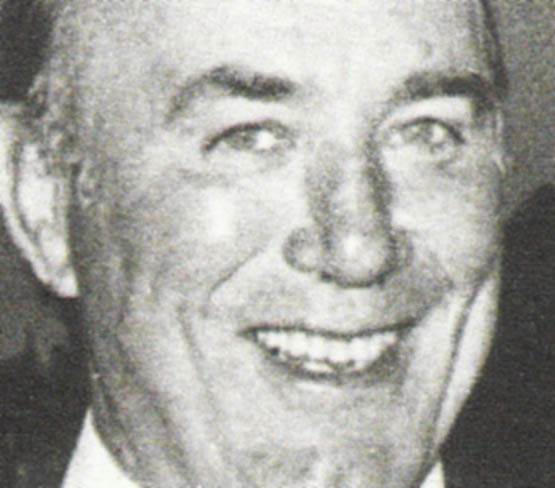
Archie O’Leary, Admiral RCYC 1977 to 1980
Today, we honour the memory of the Patriarch of this remarkable family of sailing high achievers, for Archie O’Leary was an extremely successful owner-skipper in his own right. Like many of Cork sailing’s racing aristocracy, his first proper taste of the sport was with the National 18s. But by the early 1970s he found that offshore racers best suited his tastes, and he campaigned an S&S 34 for a couple of seasons, starting to build up friendships at home and abroad which well withstood the test of time.
By late 1973, the new blossoming of Cork sailing was becoming very apparent, and while the most active campaigner Hugh Coveney went for the peak challenge of the International One Ton Cup with the state-of-the-art one-off Ron Holland-designed, George & Killian Bushe-built 36ft Golden Apple, Archie O’Leary took a different tack by commissioning a new though standard Carter 37 from the board of Dick Carter. Carter had burst upon the scene in 1965 when his innovative 34-footer Rabbit won the Fastnet Race overall, and had subsequently won the One Ton Worlds with the Dutch-American owned Tina in 1966, Optimist of Germany in 1967 and 1968, and the Italian entry Ydra in 1973.
From today’s perspective, it is difficult to grasp the scale and enthusiasm of the One Ton Worlds at Torquay in 1974. Here were more than forty red hot boats around the 36ft mark from all over the world, and all competing absolutely level, sailed in many instances by Olympic-standard crews. Many were expensive purpose-built one-offs, yet there was also a small but significant group of production boats, tuned to the One Ton rating, which were expected to be little more than cannon fodder in a field of this standard.
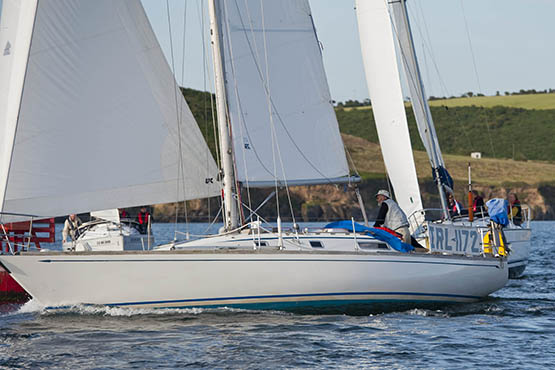
The first Irish Mist of 1974 was a standard Carter 37, and she was clear winner of the Production Boat prize at the One Ton Worlds that year
But Archie O’Leary’s standard Carter 37 Irish Mist was definitely not cannon fodder. With the young Anthony O’Leary now very much an active member of his father’s crew, Irish Mist was at the races, and then some. She won the Production Boat prize by a very clear margin, and placed tenth overall with an entire host of extremely hot one-offs astern of her.
As his sailing career progressed and developed, Archie O’Leary was to win many other major prizes, both offshore and on the championship circuit. But in later life there was no trophy he cherished more than the fine cup he’d been given in perpetuity for that Production Boat win at Torquay, for he reckoned that was purer sport than the competition he was soon to experience at the very sharpest end of international sailing.
Yet the pace was now inevitably set, and for 1975 the O’Learys commissioned a one-off Ron Holland Two Tonner, the 40ft Irish Mist II, built at Rochestown by George and Killian Bushe. This superboat really did have all the bells and whistles, complete with a Bergstrom Ridder hyper-light mast. She lived up to all her billings, winning the 1975 RORC Channel Race as a member of the Irish Admirals Cup team, in addition to many other podium places, while the following year she was overall winner of the RORC Irish Sea Race and was also top boat in the biggest regatta in Ireland that year, ISORA Week 1976 at Cork.
In the mid-1970s, the Irish Sea Offshore Racing Association was at its most numerous, and if they brought their Race Week to some venue, it guaranteed big turnouts. But ISORA had at least half a dozen and more locations to choose between – they mightn’t be back for another ten years. However, by this stage Archie O’Leary was rising through the officer ranks in the Royal Cork, and by the time he became Admiral in 1977, he’d realized that a more regular regatta week was essential for the good health of Crosshaven, and he’d plans in shape for what would become Cork Week, run on a biennial basis with the first one in 1978.
To make it all happen, he drew on firm friendships made through his years of active campaigning on the RORC and Celtic Sea programmes, and thus people like Chris Dunning from the Solent and Rob Davies from South Wales could be relied on to beat the drum for their friend Archie and his regatta in Cork, and this was to be the start of something big.
But in the best Cork traditions, while working busily in the administration of the rapidly-expanding Royal Cork YC, Admiral O’Leary continued as a very active sailor, moving on from the timber-built Irish Mist II to the glassfibre Swan 39 Irish Mist III, the production version of the fabulously successful Ron Holland-designed Regardless, and from there he went on to a Lightwave 395.
Although he was best noted for his national and international achievements, Archie O’Leary was never happier than when involved in the notably high standard of club racing against old friends at Crosshaven, when the finest traditions of the world’s oldest yacht club are given a contemporary twist.
In fact for decades – with his actively sailing family spreading onto three generations – Archie O’Leary was the very expression of the Cork sailing spirit. And even when he’d reduced the pace by changing to the Nelson powercruiser, his taste for a spot of sport afloat was undiminished. My most abiding recent memory of Archie O’Leary was of a time one Spring some years ago when his beloved Cork Constitution Rugby Club (of which he was President in 1973-74) had won through to the Irish club final, to be played at Lansdowne Road in Dublin. Archie noted that the weather pattern was settling down nicely, so he suggested to his regular shipmates that they should go in style to Dublin with the powercruiser, and use her as a houseboat for the weekend of the match.
Then as the weekend approached, a wondrous and unseasonal calm settled over all Ireland. So what did the O’Leary crew do? They came to Dublin from the north. Bound for the rugby match, they left Cork heading west, streaked up the Atlantic seaboard, roared along the north coast, zoomed down the Irish Sea to take in the match, and then went on home by sea as though this was all part of a normal weekend away for rugby fans. That was how Archie O’Leary approached life. Our heartfelt condolences go to his family and very many friends.
WMN
Ninety Boats & Counting Entered For Cork Week
With nearly 90 yachts already confirmed for the 2016 edition of Volvo Cork Week, an increase in entries from 2014 is highly likely for Ireland's most famous regatta writes Louay Habib. Hosted by the world's oldest yacht club, the Royal Cork YC, the regatta offers phenomenal racing conditions; boasting one of the world's largest natural harbours, a stunning cliff-lined coast and the Atlantic. Volvo Cork Week has the natural resources to provide some of the best racing anywhere and combined with the legendary 'craic' of Irish hospitality, and a concerted effort to drive down costs, Volvo Cork Week is a regatta not to miss.
2016 Volvo Cork Week will also host the first ever, IRC European Championship, the Irish Quarter Tonner National Championship and the inaugural Beaufort Cup.
Tony Langley's TP52 Gladiator is currently the fastest yacht competing at Cork Week.However, British entrepreneur Tony Langley will not be at the helm of Gladiator for Volvo Cork Week, as Team Gladiator Project Manager, Tom Wilson explains:
“Tony would love to be there but has other commitments. His son Bernard has taken up the challenge to lead the team. Much the same as our last regatta, which was Antigua Sailing Week, we will have a young team of talented sailors on board from Britain and also several local Irish sailors. The team is just being finalised but the youngsters will be joined by some very well known yachtsmen.”
Royal Cork's Anthony O'Leary has enjoyed tremendous success with his Ker 40, Antix, racing with his three sons, Peter, Nicholas and Robert and an all Irish crew. Anthony was the Irish Captain for both of Ireland's Commodores' Cup wins and his former boat, also called Antix, was the overall RORC IRC National Champion in 2014.
“The move to host the first IRC European Championship at Volvo Cork Week was an inspirational move by the sailing committee, the Royal Cork YC and the Royal Ocean Racing Club.” Commented Anthony O'Leary. “ To have the championship in Cork is fantastic and I am sure it is the perfect venue for what IRC is all about. There is a massive variety of courses; plenty of windward leeward but also reaching and running legs, and you never know what the Harbour Course has in store. If you sat down with a blank piece of paper to design the best courses for an IRC regatta, Volvo Cork Week has been providing it for years.”
“From the point of view of Antix, we are especially looking forward to racing against Teasing Machine. In the 2010 Commodores' Cup, in her former life as Catapult, the Ker 40 had a great battle with Teasing Machine and we look forward to that. There are similar battles right through all the classes and to have twice as many boats already entered compared to the same time in 2014, we are hoping for a large number of quality boats enjoying an outstanding regatta.
Laurent Pages has competed in the last two editions of the Volvo Ocean Race, winning the round the world race with Groupama in 2014 and will be tactician for Eric De Turkheim's French A13, Teasing Machine for Volvo Cork Week.
“With the intention to race around Ireland in June, Volvo Cork Week was really an option for us. The fact that IRC European Champion title will decided at Volvo Cork Week was also a key point.” commented Laurent. “Teasing Machine will come with a lot of ambition but we know the competition will be really fantastic ! It's a great challenge ! And always a great pleasure to come to Ireland !
To have a variety of racing conditions is absolutely great: mixing pure inshore races and coastal races gives so much interest and it all makes sense to contend an IRC European Title in that way. Irish sailors will be really hard to beat in their home waters and we also know that top British teams will be highly competitive, as always but we will defend the french chances with determination and passion!”
Oystercatcher XXXI is the third boat to be designed for Sir Richard Matthews by Tom Humphreys and should be launched 8th June, after fitting out at Fox’s Marina Ipswich. Oystercatcher XXXI will be making its debut at Volvo Cork Week, although Sir Richard has been coming for years.
“A return to a genuine dual purpose cruiser racer, a proper cockpit, berth for every crew, H&C water including a shower and a proper galley with an oven - all in less than 39 feet and 86 feet shorter than my ‘other’ boat!” laughed Richard. “Cork Week has always been friendly and it is even better now that it's more of a regatta and less of a pop concert and I prefer Murphy's.
The race courses are varied and interesting and I especially enjoy the Harbour Course. Oystercatcher's crew will be mostly our East Coast (UK) regulars (some of whom are still young enough to walk unaided!) and Eddie English our dear friend from Cobh, who has done the last 8 or 10 Cork Weeks with us. All of the crew are keen golfers and The Old Head of Kinsale is one of the best courses in the world and is a fine start or finish to the week.”
“I live just up the road, I have to come every regatta! I enjoy the competition, the professional race management, variety of courses on offer, the onshore entertainment and the camaraderie. This year I think that it is great that the IRC European Championship is part of it. Jump intend doing the Irish, UK and Welsh IRC nationals so it's a great fit to our programme.
It is really tough to win your class at Volvo Cork Week, because all the good boats and best sailors are there. Competition, varied conditions and courses and a lively social scene all mitigate against predictability. Not until the skipper and crew look each other up and down each morning can one make any presumptions. A lot depends on the night before! Having gone through the rock concert type event some years ago the event is firmly fun for sailors mostly on site. Expect great craic, late nights and sore heads.”
Simon Henning's British Mumm 36, Alice is returning to Volvo Cork Week after a long absence, as Simon explains: “We did Cork Week in 2006 and 2008 in Farr 45, Alice 2 but the Mumm 36, Alice was last at Cork Week in 2004, she has had a major refit and is much more competitive, the first IRC European Championship is the big attraction to come back this year and we are looking forward to a very competitive week. Also Cork is a great place to sail with a variety of conditions and it is rare you get a windless day. For me personally, the older you get, the more you need to grab the opportunities that come along.”
The IRC European Championship is attracting new teams from overseas of a very high standard and the Beaufort Cup is bringing new faces to Volvo Cork Week. The Beaufort Cup invites sailing teams from their associated national services, 50% of each team must be active in the service they represent. Racing will take place over five days in a mix of offshore and inshore courses. The winning team will also have €10,000 donated to a nominated charity.
Cork Week Early Entry Discount Deadline Looms
With the early entry discount for Volvo Cork Week running out on May 1st Royal Cork Yacht Club organisers have been keen to point out innovations for the 2016 edition such as the first ever IRC European Championship and the Beaufort Cup as part of this summer's line–up.
'RCYC has always listened to competitors comments about Cork Week and has never been afraid to make improvements whenever possible', the club say in its latest mail out to competitors
Kieran O'Connell, Chairman of Volvo Cork Week, spoke candidly about the changes to this year's event, brought about by talking to competitors, the real cost of coming to Cork Week is being reduced by pro-active measures.
“When talking to people in Ireland and the UK." commented Kieran O'Connell. "We have been making a big effort to keep the cost down for visiting teams, we have been setting guide prices for local accommodation in Crosshaven and local home owners have been listening and reducing their expectations. For example a 3 bedroom house that sleeps 6 - 8 crew for the week is averaging at €1250 - €1500 or B&B for €50 per night. In 2016 there will also be camping options with toilet and shower facilities.
The committee have undertaken to keep food and beverage costs at normal club rates. Helly Hansen, the Official Clothing Partner to the event will have a retail shop in the regatta village, alongside other notable retailers such as CH Marine and Union Chandlery.
The entertainment line-up is fantastic this year with the event open to the public on Thursday and Friday nights with big name bands performing. The management team is putting a big effort into the apres-sail slot from 4.30 to 7pm, with live music creating the right sort of atmosphere, as the sailors come off the water.
The IRC European Championship is attracting new teams from overseas of a very high standard and the Beaufort Cup is bringing new faces to Volvo Cork Week. The Beaufort Cup invites sailing teams from their associated national services, 50% of each team must be active in the service they represent. Racing will take place over five days in a mix of offshore and inshore courses. The winning team of the Beaufort Cup will also have €10,000 donated to a nominated charity.
For yachts entering before the end of April, there is a prize draw for sailing gear and a weekend 40ft bareboat charter.
Including the one design 1720 and Viper Sportsboats, a wide variety of yachts have already entered Volvo Cork Week, with a significantly higher number of early entries compared to this time in 2014. For yachts entering before the 1st May 2016, there are two prize draws. Volvo Cork Week will be giving away, sailing gear and a weekend 40ft bareboat charter, kindly sponsored by Sovereign Sailing Kinsale.”
The early entry discount for Volvo Cork Week runs out on May 1st.
New Group Wants To Reclaim Irish Sailing For The Republic
The recently-formed maritime association SOAR (Sailors Of A Republic), which claims to have a nationwide membership, today outlines its plans to reclaim the yacht and sailing clubs of Ireland into a truly republican spirit.
“In view of the successful and generally peaceful nature of the Easter Rising celebrations this week,” a spokesman told Afloat.ie, “we feel the opportunity has been provided to reveal how we will give Irish sailing organisations a completely new image in keeping with the re-born spirit of the times.”
“We would point out” the spokesman continued, “that when the Water Club of the Harbour of Cork was founded in 1720, despite the connections to English royals of some of the founding members, there was none of this royalty nonsense in the title of the new club. And it cannot be claimed that there was no precedent for such a thing. Several scientists – who were to include Robert Boyle of Cork – had got together to found the Society for Improving Natural Knowledge in November 1660, and it very quickly was given the title of the Royal Society.”
“Yet even through its quieter years on Cork Harbour in the late 1700s, the pioneering group of sailors in Cork was always proud to be known simply as the Water Club. It was only many years after the last of the original founders had died that the club contemplated re-titling itself, and it was in the beginning of the era of new yacht club formations in the early 1800s that it allowed itself to become the Royal Cork Yacht Club”.
“At its most simple” the SOAR spokesman said, “what we are seeking is a re-branding exercise. But we are mindful of the recent public annoyance caused by the re-branding of Eircom as Eir, which cost something in the region of €16 million. Thus our special SOAR Nomenclature Sub-Committee has been looking at ways of minimising the cost of a changeover, particularly as it could mean Ireland’s royal yacht clubs would feel they are being discriminated against.”
“Their boat owners would understandably have a special grievance if badly thought-out recommendations put them to extra expense in changing the initials of their club on the transoms of their boats.
But fortunately the words “royal” and “republic” both begin with the letter “R”. So with some foresight, the only expense would be in the detail of club letterheads, in-house notices and so forth, which we fell the truly republican-minded sailors of Ireland will be happy to bear as a group”.
“In order to ensure there is no unnecessary change in the lettering of club initials on boats, our Committee have decided that the Royal Irish Yacht Club will become the Republic of Ireland Yacht Club, or alternatively the Real Ireland Yacht Club. As for the Royal St George Yacht Club, it will become the Republican St George YC. And a real flash of imagination is being shown towards the pioneering spirit of south coast sailing - the Royal Cork Yacht Club will in future be known as the Rebel County Yacht Club”.
However, it is understood that there will be one exception to the proposed name changes. Another source has revealed to Afloat.ie that the Royal Western Yacht Club of Ireland in Kilrush will be allowed to keep its current title. “We are of the opinion that County Clare’s links with Brian Boru provide a royal connection to a real Irish king, a connection which long pre-dates any foreign incursions. We are entirely in favour of keeping the royal titles if we can find a link to our own royalty, and in Brian Boru country, that is easily done.”
The Royal Ocean Racing Club (RORC) is promoting its inaugural European IRC Championship as part of Cork Week. The London club says the event will 'bring countries together'.
The International IRC Rating Rule, jointly owned by the Royal Ocean Racing Club (RORC) and l’Union Nationale pour la Course au Large (UNCL) will be attracting boats from all over the world to the port of Crosshaven in Ireland this year. From 10th to 15th July 2016 the Inaugural European IRC Championship will be take place during the already well-established and popular Volvo Cork Week hosted by the Royal Cork YC, the world’s oldest yacht club.
This exciting addition to the global IRC racing calendar promises to bring boats together from all corners of Europe, where over 4300 boats are IRC rated annually, but is open to all 6000 boats IRC rated worldwide. The Championship invites entries from boats with a valid 2016 IRC rating between 0.850 and 1.320 and the RCYC is expecting entries from 'around the globe'. Early entries include boats from Ireland, Northern Ireland, the UK, France, the USA and Australia, with interest from South Africa, making it a truly international event.
Back in 1990 Cork Week was the first regatta in the world to use the now ubiquitous windward/leeward race format, but even then the regatta included an innovative and varied mix of racing and 2016 is no exception: courses at the European IRC Championship will include Olympic, trapezoid, slalom and windward/leeward buoy courses plus an 8 hour coastal race, so every boat has a chance to shine on their preferred course type. Results will be calculated using the simple time-on-time IRC time corrector, so competitors can easily see how they are performing around the course.
Another addition to the Week this year is the inaugural International Inter Services Sailing Competition, the Beaufort Cup. Volvo Cork Week 2016 is shaping up to be another unforgettable regatta, and if you have a 2016 IRC rating you can be part of it!
Moonduster Looking Sad This Morning In Trondheim, Meeting About Her Future In Royal Cork Yacht Club This Evening At 7pm
The great Denis Doyle’s star-quality Frers 51 Moonduster of 1981 vintage, built in Crosshaven Boatyard with the legendary Dick Leonard in charge of the construction details and the then-locally-based designer Tony Castro as consultant, is in a sorry state in Trondheim in Norway. This has been her home port since she was sold there in 2005 following The Doyler’s death in the Autumn 2001, after he’d sailed his last Fastnet Race aboard her that summer aged 81 writes W M Nixon
The condition of the iconic Moonduster has recently been a topic of busy conversations on Afloat.ie, and this evening in the Upstairs Bar of the Royal Cork Yacht Club at Crosshaven, an exploratory open meeting will be held at 7.0pm to gauge the level of interest in this very special boat, and hear opinions about what best can be done about her future.
As it happens, leading Crosshaven sailing couple Brian and Eleanor Cudmore overnighted in Trondheim last night while on a Hurtigurten ship cruise to the far north along the Norwegian coast. This morning before sailing they made a point of returning to Monduster (which they’d seen in the dark yesterday) to send us these up-to-date photos of the state of a still-great yacht, albeit one that has fallen in hard times.
In the last analysis, much will depend on a proper survey. But nevertheless from these photos she looks to be eminently restorable to her former stylish glory, though where there has been a small hull puncture – as in the starboard side – it will take a good eye and experience of how varnished wood changes colour to properly match in any new timber required.
Read also: Why Moonduster Should Not Make Ireland Her Home After Restoration
Royal Cork Yacht Club Second At Greek 2K Team Racing Regatta
The Royal Cork Yacht Club was represented last weekend at a 2K Team Racing Regatta hosted by the Yacht Club of Greece. The two boat team, skippered by Fred Cudmore and George Kingston finished second, to a very strong Spinnaker Auspicious team, representing Spinnaker Sailing Club, UK.
The racing took place on the Saronic Gulf, in Plateau 25s, over 3 days. The Royal Cork were joined by 7 other teams, representing 5 different countries. ‘2K’ (2 keelboats) racing is a form of team racing where two boats sail against an opposing set, around a short and exciting course.
The RCYC team consisted of Fred Cudmore, Lisa Tait, Philip, Sarah and Eimear O’Leary, George Kinston, Emma Geary and Philip McGlade.
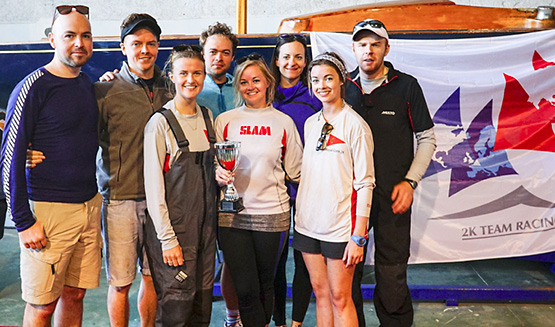
Royal Cork team pick up a trophy for second place. Left to right: Philip McGlade, George Kingston, Emma Geary, Philip O'Leary, Eimear O'Leary, Lisa Tait, Sarah O'Leary and Fred Cudmore
Day one of the regatta was unfortunately blown out due to high winds. Day 2 saw a long day on the water for all 7 teams, with a variety of wind conditions ranging from about 8-15 knots. The Royal Cork got off to a slow start, falling victim to the local knowledge of the Greek team off the startline, in what shaped up to be tense race with a flurry of protesting. The team regrouped and won all but one race that day, narrowly losing out to the Brits. RCYC finished the day lying in second, while Spinnaker Auspicious set the pace from the outset, with no losses at all that day.
After a long wait onshore on the Sunday morning of day 3, the teams went afloat, to contest part of a second round robin. The Irish won all of their races, allowing them a place in the final, to come head to head with Spinnaker once again.
The breeze was up, and there were champagne sailing conditions for the best of 3 final, with the stunning backdrop of Athens behind. The first race got off to a disappointing start, with the Brits enjoying a significant weight advantage and took off from the start line in what became a drag race around the course. The second race was much more hotly contested, with all RCYC team members hailing loads from the pre-start. Cudmore perfectly executed a duel with Brittish skipper Tom Hebbert, holding him off at the start, and Kingston started favourably against his counterpart, Sam Littlejohn on the left hand side of the course. The RCYC defended brilliantly throughout the first half of the race, but the Brits with the speed advantage fought back in an extremely intense final downwind and pulled off a well timed sweep at the very end, securing their 2-0 victory.
The Yacht Club of Greece provided hospitality, while the 2K committee led by Bruce Hebbert ran a great show as always. Next stop on the 2K circuit for the RCYC team is likely to be Gaeta, Italy in July, where the team will be gunning for their first victory.
2K Athens Results: 1st Spinnaker (GBR) , 2nd Royal Cork Yacht Club (IRL), 3rd Yacht Club Costa Olanda (NED/ITA), 4th Yacht Club Costa Smeralda (ITA), 5th Yacht Club Greece (GRE), 6th Team Chaos (GER/NZL), 7th DMTRA (NED)
RS400s Hit The Water At Royal Cork Yacht Club
Five RS400s hit the water in Cork on Saturday, the first day back for a fleet that has now grown to 11 boats in Cork Harbour.
Hosted by the Royal Cork Yacht Club, racing took place on the Curlane Bank and the 10 hardy souls completed 5 races in glorious sunshine and winds gusting to 25 knots.
John Downey and Sandy Rimmington of Monkstown Bay were clear winners on the day with a score line of three 1sts and two 2nds.
Dublin based dinghy supremos Barry MacCartin and Ronan Wallace were a convincing second and are proving to be the ones to watch for the regional circuit.
Twice national champs Alex Barry and Richie Leonard could only manage third however were delighted with their swimming practice.
George Kenefick paired up with Royal Cork junior Harry Durcan and they finished fourth, also getting in plenty of swim time as they blew off the cobwebs.
New to the class Tom McGrath rounded it out in 5th. It was great to see the young blood getting involved and Junior ace Harry Durcan joined Tom, moving to the front of the boat for the first time.
Thanks to OOD Ciaran McSweeney and all of his helpers on the day.
The class have a packed local and national schedule this year as they build towards the nationals in Schull in August.
This week’s sad video on Afloat.ie about the dilapidated and deteriorating condition of the late Denis Doyle of Cork’s very special Frers 51 Moonduster in northern Norway has led to a flurry of communication on social media, and all sorts of suggestions about how best she might be restored and used in the future. Inevitably, there have been many who reckon she should find her future back home in Ireland, and be properly restored here. W M Nixon isn’t so sure.
There was a period recently when the word “iconic” appeared so frequently as to become meaningless. But fortunately we’ve moved on from that level of gross over-use, and a certain rigour has returned to the deployment of this very useful and eloquent adjective. Which is just as well, for when you try to tell today’s rising generation of offshore sailors just what Denis Doyle and Moonduster meant to us during their twenty years of glory from 1981 to 2001, “iconic” and “inspirational” are the only words which will hit the target.
In fact, the complete force was a threesome, as it was Denis Doyle and his wonderful and supportive wife Mary (nee Woodward) and Moonduster. But even when Mary had passed on in 1993, such was the strength of the team inspired by them that Denis and Moonduster continued actively campaigning at home and abroad with the support of an army of friends. He did his final Fastnet Race with Moonduster in 2001 aged 81, and was gone from among us by the Autumn.
To say that Moonduster looked forlorn in the big shed in the winter of 1981-82 at Crosshaven Boatyard where she had been built is scarcely to begin to grasp just what “The Doyler and The Duster” had meant to Cork and to Irish sailing and to world offshore racing. They represented a level of commitment to the sport and to the communities it involved which few other people-and-boat combinations could match.
Awareness of this first came to me this in Cowes in the summer of 1969, when we’d taken a 35ft boat we built in Carrickmacross (as one does) down south to do Cowes Week and the Fastnet Race. We seemed to spend a lot of time in Groves & Guttridge’s yard with much hammering being heard from within our County Monaghan boat, and our only consolation was that there was even heavier hammering coming from within Dick Carter’s innovative Red Rooster beside us on the hard, with her huge lifting keel continuing to give problems.
Subsequently, Red Roooster went on to win overall in the Fastnet, while we with our very homemade boat were 122nd out of 250 entries - it truly took a helluva lot of boats to beat us. Yet it takes an effort to remember all that. But what I do remember vividly is a little exchange on the balcony of the Island Sailing Club where I was taking a break from the boatyard mayhem and maybe enjoying a beer or three, and certainly a breath of fresh air in the sunshine, as the last of the fleet from that day’s New York Yacht Club Cup race came into port.
Conspicuous among them was Denis Doyle’s first Moonduster, the very handsome Robert Clark-designed white 47–footer built in Crosshaven Boatyard in 1965. Moonduster was particularly conspicuous because, unlike the other boats coming up the Medina River under engine, she was being sailed by Denis with consummate skill, for he disdained to have an auxiliary engine, as had also been the case with his first Crosshaven-built Robert Clark offshore racer, the 38ft Querida of 1963.
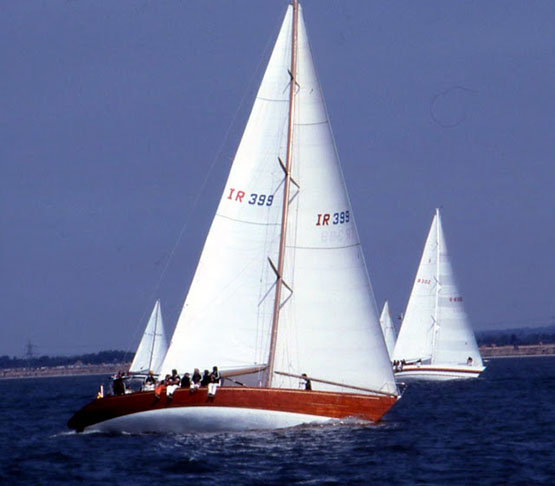
The Solent was only one of many venues to which Denis & Mary Doyle & Moonduster gave total commitment. This is the new Moonduster racing in the Admirals Cup of 1981.
Foolishly, I made some quip about the mad Doyler and his engine-less boat to a formidable matron who was beside me in the balcony crowd. She put me very firmly in my place. It emerged she was Denis and Mary’s Cowes landlady, and she was on the balcony to see her hero sail into port. It seemed that, ever since Denis and Mary and whatever boat they happened to be campaigning that year had been coming to Cowes, after careful research they’d selected this woman’s Bed & Breakfast to be their Cowes base. And they had stayed loyally and on the best of terms with her ever since. In the hierarchy of Cowes landladies, this put her very high up the pecking order.
“If a few more of these supposed gentlemen yachtsmen coming to Cowes Week brought the same sense and level of support, respect, generosity, consideration and kindness to the local folk as Mr & Mrs Doyle do, then Cowes would be a much more prosperous and happy little town” I was crisply informed.
You remember little exchanges like that long after numerous Cowes Weeks and three Fastnet Races have become a hazy memory. And the sign-off line was the killer punch. “On top of their friendliness, after Mary has seen Denis off in the Fastnet Race or whatever race is taking Moonduster away from Cowes, she’ll always drop by to say goodbye until next time, and present me with a lovely bouquet of flowers”.
The Doyler’s boat-owning history was fascinating. His first higher- visbility campaigning was with a Cork Harbour OD, but then for a while he took his first serious steps offshore with the converted 6 Metre Vaara. But it was with the 30 Square Metre Vanja IV – which he bought from Lough Derg – that he began to do more serious offshore stuff verging on into RORC events, which he continued with the “Straight Eight” Severn II, one of a group of impressive International 8 Metres which set the tone in Crosshaven in the 1950s and 60s.
However, having bought Crosshaven Boatyard to add to his extensive maritime business portfolio, he linked up with that noted designer of elegant offshore racers Robert Clark to build the 38ft Querida in 1963, and the much-loved 47ft white Moonduster (named after a racehorse) in 1965, with the link-up reaching a peak with Francis Chichester’s last boat, the Clark-designed Gypsy Moth V, in 1970.
As for Denis Doyle, the white Moonduster was succeeded in 1973 by the blue Moonduster, a massively powerful 47ft Sparkman & Stephens design which, alas, came to an unhappy end in the Pacific some years ago. But Denis Doyle had long since moved on, for after her for two or three years he had a fibreglass Ron Holland-designed Swan 44, a standard boat which couldn’t quite compete with one-offs, yet she was the only member of the Irish Admirals Cup Team of 1979 which managed to finish the disastrously storm-tossed Fastnet Race of that year.
But by 1980 The Doyler’s heart was set on a new Frers 51-footer which was to be wooden built multi-skinned in Crosshaven Boatyard. She was the absolute essence of Frers in style and appearance, yet the name Moonduster appears only once in an offhand sort of reference in the official Frers book, A Passion for Design. For if memory serves aright, German Frers allowed Dick Leonard of Crosshaven Boatyard access to the lines of the hugely successful alloy-built Frers 51 footer Blizzard, and Dick went to work and developed the detailed plans for wooden construction while the young up-and-coming Crosshaven designer Tony Castro was called in as consultant when added expert help was needed.
Thus Moonduster may have been Frers without, but she was pure Crosshaven within. And my goodness, but she was good-looking. When she first appeared in the nick of time for the Irish Admirals Cup trials in May 1981, you didn’t really look at any other boat. An elegantly varnished hull with effortlessly powerful performance, this new Moonduster was a yacht as yachts should be.
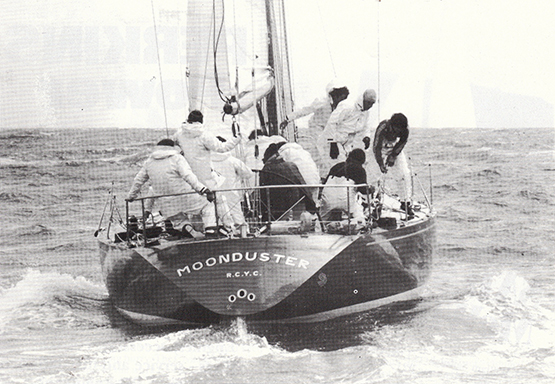
“An elegantly varnished hull with effortlessly powerful performance…..” Moonduster off Cork in May 1981. Photo: W M Nixon

“There was only one boat to look at”. Moonduster leading the fleet in the 1981 trials. Photo: W M Nixon
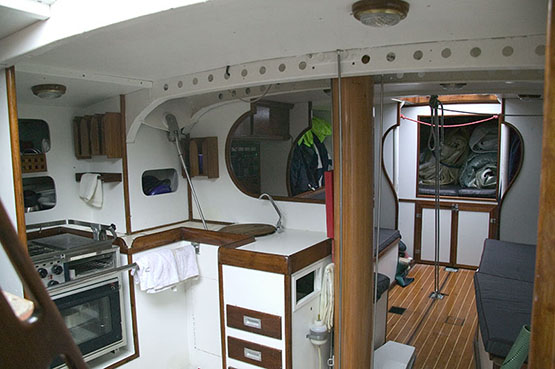
Moonduster’s interior is functional yet attractive
And though in some sense she may have been “unofficial Frers”, all I know is that a few month after her successful first season, when the 1982 Falklands War was under way I received a circuitous request from Buenos Aires for a print suitable for framing and wall-hanging of that photo of mine which appeared in the poorly-printed cover of the June/July 1981 Irish Boats & Yachting, one of the incarnations of Afloat. In due course, the carefully rolled and packaged print found its way past the war and on into Argentina and the Frers establishment, where presumably it joined the wall display among other classic Frers designs where Moonduster so rightly belonged.
But getting the photo to Mr Frers was only the beginning of The Last Moonduster Story. In 1982 Denis and Mary and Moonduster committed themselves to the Round Ireland Race and Wicklow with the same devotion that they gave to the Fastnet Race and Cowes in alternate years, and it was the making of the event, with Moonduster establishing a good record in 1982, and then an incredibly good Round Ireland record in 1984 which stood for many years.

The beginnning of a great relationship – Moonduster approaching Wicklow for the finish of the Round Ireland Race of 1982.

“The gang’s all here”. Moonduster on the way to her enduring Round Ireland record in the race of 1984, with Neil Hegarty on the helm (left), Donal McClement on the mainsheet, Brendan Fogarty (foreground), Davy Harte, and the late Grattan Roberts.
But involvement with Wicklow and Cowes at the appropriate times was only part of the Moonduster mystique. Another indirect Moonduster recollection that springs to mind is of stepping in to the Club Nautico de Montereale or whatever it’s called in Bayona in northwest Spain in 1995 after sailing out from Ireland across Biscay, and there was the Commodore honours board and beside it the honorary members list, and the top of the latter was one King Juan Carlos and beside him was Denis N Doyle. Moonduster enjoyed bringing a bit of real style to the scene in northwest Spain, while Juan Carlos was an old friend from the Admirals Cup years of the mid-70s, and they partied mightily when he came aboard Moonduster at Cabrera when the Irish boat was on her way to the Sardinia Cup at Costa Smeralda.
But whoever it was, king or crewman, Denis was the same utterly straight Denis Doyle. Photographers tried to capture the spirit of this very remarkable man, but it was impossible to get the essence of his character, for without being a fidget in any way, he was a man of action, and his character was most purely expressed through what he did.

Even the best photographers had difficulty in capturing the essence of Denis Doyle in a portrait, for he was what he did. Photo courtesy RCYC
So when he died, it was only natural that nobody in Cork or Ireland wanted to take on Moonduster. It was a great relief when eventually she was sold to Trondheim far in the north of Norway for a sail training school, for in some ways that was what she had been in the Doyle ownership, with his great shipmate Colonel Barney Goulding introducing platoons of young soliders who became great crewmen, for unlike navy cadets, they didn’t come aboard with any preconceived notion of how a boat should be sailed and run.
But now the care of Moonduster in Norway has apparently gone pear-shaped and beyond. A saviour and guardian angel is urgently required. And if you insist and can organise it, by all means get her restored to full health in Ireland. But once that’s done, please take her away to join the classic offshore racers group in the Mediterranean. Take her away and keep her away for a good while yet. Fifteen years may have passed. But we’re still not ready to see Moonduster sailing in Ireland again without The Doyler at the helm.

In her early days in Norway, Moonduster seemed to have settled well in her new home



























